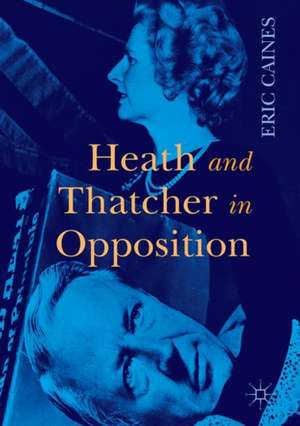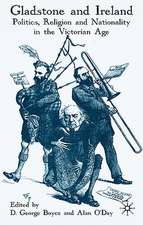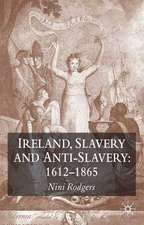Heath and Thatcher in Opposition
Autor Eric Cainesen Limba Engleză Hardback – 23 iul 2017
Against a national background of declining economic status, high inflation, debilitating public sector strikes and internal Conservative Party debates, particularly over industrial relations policy and monetarism, they adopted strikingly different approaches to policy-making in Opposition. The book illustrates how, paradoxically, Heath’s technocratic over-prescription failed to save his eventual premiership, while Thatcher’s under-committed policy design failed to impede her leading a purposeful and transformative government i
n the 1980s.
| Toate formatele și edițiile | Preț | Express |
|---|---|---|
| Paperback (1) | 215.92 lei 6-8 săpt. | |
| Palgrave Macmillan UK – 13 dec 2018 | 215.92 lei 6-8 săpt. | |
| Hardback (1) | 701.40 lei 6-8 săpt. | |
| Palgrave Macmillan UK – 23 iul 2017 | 701.40 lei 6-8 săpt. |
Preț: 701.40 lei
Preț vechi: 825.17 lei
-15% Nou
Puncte Express: 1052
Preț estimativ în valută:
134.21€ • 146.24$ • 113.09£
134.21€ • 146.24$ • 113.09£
Carte tipărită la comandă
Livrare economică 23 aprilie-07 mai
Preluare comenzi: 021 569.72.76
Specificații
ISBN-13: 9781137602459
ISBN-10: 1137602457
Pagini: 314
Ilustrații: XIV, 314 p.
Dimensiuni: 148 x 210 x 24 mm
Greutate: 0.54 kg
Ediția:1st ed. 2017
Editura: Palgrave Macmillan UK
Colecția Palgrave Macmillan
Locul publicării:London, United Kingdom
ISBN-10: 1137602457
Pagini: 314
Ilustrații: XIV, 314 p.
Dimensiuni: 148 x 210 x 24 mm
Greutate: 0.54 kg
Ediția:1st ed. 2017
Editura: Palgrave Macmillan UK
Colecția Palgrave Macmillan
Locul publicării:London, United Kingdom
Cuprins
Chapter 1: Introduction.- Chapter 2: The nature of Conservatism.- Chapter 3: Decline and Fall I.- Chapter 4: Getting used to being out of office.- Chapter 5: Reasons (or excuses?) for failure.- Chapter 6: The road to Selsdon.- Chapter 7: Decline and Fall II.- Chapter 8: Decline and Fall II.- Chapter 9: Keith Joseph’s ‘Third Crusade’.- Chapter 10: Internal warfare.- Chapter 11: The inflation nettle.- Chapter 12: The industrial relations nettle.- Chapter 13: Thatcher – ideologue or pragmatist?.- Chapter 14: Conclusion – Heath and Thatcher in Opposition.- Bibliography.- Index
Recenzii
“The book can perhaps best be seen as a study of the adaptations of British Conservatism during the period seen by many as corresponding to the breakdown of the post-war settlement. … One of the most prominent dimensions of this book is that it places Thatcher back into a context which her long period in office and iron lady image have subsequently obscured.” (Trevor Harris, cercles.com, December, 2017)
Notă biografică
Eric Caines was a career civil servant who served at senior levels in Whitehall, UK, and at the International Monetary Fund in Washington, DC. He has written prolifically on management matters and is an expert on industrial relations, particularly as they interface with politics.
Textul de pe ultima copertă
This book traces how Edward Heath and Margaret Thatcher, during their respective years as Conservative Opposition Leaders (1965-70 and 1975-79), managed their Party’s attempts to ensure a return to government, each after two electoral defeats. They did so in the context of an emergent New Conservatism, championed by the likes of Enoch Powell, Keith Joseph and Nigel Lawson, which betokened a long-term change from the post-war Butskellite settlement.
Against a national background of declining economic status, high inflation, debilitating public sector strikes and internal Conservative Party debates, particularly over industrial relations policy and monetarism, they adopted strikingly different approaches to policy-making in Opposition. The book illustrates how, paradoxically, Heath’s technocratic over-prescription failed to save his eventual premiership, while Thatcher’s under-committed policy design failed to impede her leading a purposeful and transformative government i
n the 1980s.
Against a national background of declining economic status, high inflation, debilitating public sector strikes and internal Conservative Party debates, particularly over industrial relations policy and monetarism, they adopted strikingly different approaches to policy-making in Opposition. The book illustrates how, paradoxically, Heath’s technocratic over-prescription failed to save his eventual premiership, while Thatcher’s under-committed policy design failed to impede her leading a purposeful and transformative government i
n the 1980s.
Caracteristici
Assesses how these two leaders controlled and directed the Conservative party to revive its electoral appeal
Provides insight into how the Conservative Party developed policies in the sixties and seventies
Traces the spectrum of Conservatism from Butskellism to Thatcherism
Provides insight into how the Conservative Party developed policies in the sixties and seventies
Traces the spectrum of Conservatism from Butskellism to Thatcherism












